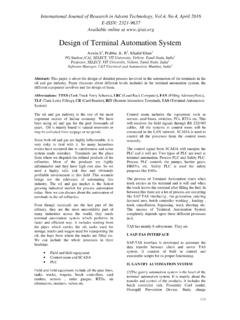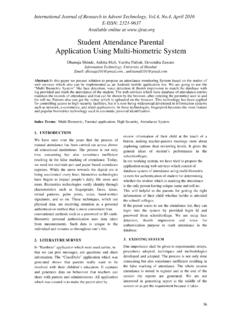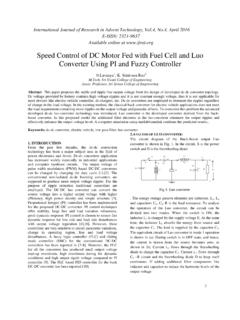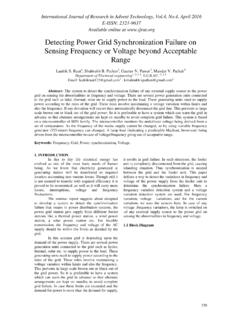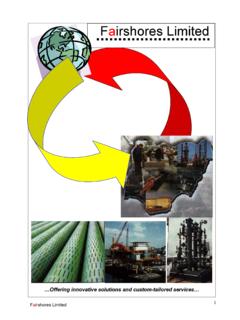Transcription of Analysis of improvement of Heat Transfer in …
1 International Journal of Research in Advent Technology, , , April 2016 E-ISSN: 2321-9637 Available online at 169 Analysis of improvement of heat Transfer in Rectangular Channel Fitted with V-Shaped Ribs Harde1, R. Chamatkar2, Kadam3, Md. Mechanical Engineering Department, Priyadarshini College of Engineering 1, 2, 3 Civil Engineering Department, Priyadarshini College of Engineering 4 Email: Abstract:- Experimental investigations have been carried out to study the effects of the V-Shaped ribs of different angle (45 and 30 ) on the performance rectangular duct. heat Transfer coefficient and friction factor are analyzed with using mentioned passive heat Transfer enhancement methods. This paper presents the experimental Analysis of heat Transfer enhancement in rectangular channel with v-shaped ribs and its effect on the heat Transfer rate. Experimental study shows that the heat Transfer rate increases with the v-shaped rib of 45o and 60o with the rate of and respectively.
2 Also the rate of heat Transfer rate further increases when we used broken v-shaped ribs 45o and 60o by and Index Term- heat Transfer enhancement. V-shaped ribs, rectangular channel 1. INTRODUCTION The operation of many engineering systems results in generation of heat . This unwanted by product cause serious overheating problems and sometime lead to failure of system. The heat generated within the system must be dissipated to its surrounding in order to maintain the system at it s recommended working temperature and functioning effectively and reliably. This especially important in cooling of gas turbine blades, process industries, cooling of evaporators, thermal power plants, air conditioning equipment radiators of space vehicle and automobiles and modern electronic equipments. In order to overcome this problem, thermal system with effective emitters as ribs, fins etc.
3 Are desirable. The need to increase the thermal performance of the systems, thereby affecting energy, material and cost savings have led to development and use of many techniques termed as heat Transfer Augmentation . This techniques also termed as heat Transfer Enhancement or Intensification . Augmentation techniques increase convective heat Transfer by reducing the thermal resistance in a heat exchanger. Like jet impingement, baffles, and other heat Transfer enhancement techniques, insertion of ribs in heat Transfer devices is popular to promote better mixing of the coolant and increase cooling performance. Applications of the Z-shaped ribs may be in gas turbine blade coolant path, air-cooled solar collectors, heat exchangers, and power plants. The ribs are usually attached to the heated surface to augment heat Transfer by providing additional area for heat Transfer and better mixing.
4 heat Transfer augmentation techniques refer to different methods used to increase rate of heat Transfer without affecting much the overall performance of the system. These techniques broadly divided in two groups viz. passive, and active. Active techniques involves some external power input for the enhancement of heat Transfer , some examples of active techniques include induced pulsation by cams and reciprocating plungers, the use of a magnetic field to disturb the seeded light particles in a flowing stream, etc .and Passive techniques generally use surface or geometrical modifications to the flow channel by incorporating inserts or additional devices, for example, use of inserts, use of rough surfaces etc. 2. LITERATURE REVIEW Dong Hyun Lee a, Dong-Ho Rhee b, Kyung Min Kim a, Hyung Hee Cho a, Hee Koo Moon [12], Performed Detailed measurement of heat /mass Transfer with continuous and multiple V-shaped ribs in rectangular channel.
5 They Investigated Effects of aspect ratio on heat /mass Transfer were investigated in rectangular channels with two different V-shaped rib configurations, which are continuous V-shaped rib configuration with a 60 attack angle, and multiple (staggered) V-shaped rib configuration with a 45 attack angle. They concluded Effects of aspect ratio on heat /mass Transfer were investigated in rectangular channels with two different V-shaped rib configurations, which are continuous V-shaped rib configuration with a 60o attack angle, and multiple (staggered) V-shaped rib configuration with a 45o attack angle. The square ribs were attached on the test section in International Journal of Research in Advent Technology, , , April 2016 E-ISSN: 2321-9637 Available online at 170 a parallel manner. A naphthalene sublimation method was used to measure the local heat /mass Transfer coefficients.
6 For the continuous V-shaped rib configuration, two pairs of counter-rotating vortices were generated in the channel, and high Transfer region was formed at the center of the ribbed walls. However, for the multiple V-shaped rib configuration with 45o attack angle, asymmetric secondary flow patterns were generated due to its geometric features, resulting in uniform heat /mass Transfer distributions. The effect of channel aspect ratio was more significant for the continuous 60o V-shaped rib than for the multiple 45o V-shaped rib configuration. A fluid flow channel is easily found in various energy conversion systems. Enhancing convective heat Transfer in a channel can improve the durability of hot components of gas turbine engine, the effectiveness of heat exchanger and the efficiency of solar air heater, etc. heat Transfer can be improved by installing various turbulators such as ribs, dimples and baffles.
7 Introducing ribs to a coolant channel is one of the most typical methods to enhance heat Transfer between solid surfaces and fluid flow. The rib turbulators augment heat Transfer in the internal cooling passages because they cause flow separation and reattachment, which result in breakage of the laminar sublayer. In addition, when the angled ribs are installed in a channel, the heat Transfer is enhanced with generated secondary flow structures. Karwa et al. reported that 10w40% augmented thermal efficiency was obtained by installing ribs on the absorber plates of solar air heaters. In the last few decades, many studies have been performed to find optimal conditions of various rib design parameters include rib height, angle of attack, rib-to-rib pitch and rib arrangement. Mittal et al. compared the efficiency of various roughness elements and concluded that inclined ribs including V-shaped ribs possessed better efficiency in the higher range of Reynolds number (more than 12,000).
8 In recent years, the V-shaped rib configurations have been widely investigated. Choi et al. measured the detailed heat /mass Transfer distribution in a square channel with V- and L-shaped continuous/discrete ribs. The results showed that continuous L-shaped ribs had higher heat Transfer rate than the other ribs. However, discrete L-shaped ribs showed better thermal performances due to the low friction loss. Lau et al. investigated the average and local heat Transfer characteristics in a square channel with V-shaped rib arrangements. They reported that 60 and 45 V-shaped ribs enhanced heat Transfer on both ribbed and smoothwalls, but caused higher pressure drop than angled full ribs. Han et al. studied the V- and L-shaped ribs with a different angle of attack and compared the results with simple angled rib cases of parallel/cross arrangements.
9 The research demonstrated that the 60o ribs had higher heat Transfer coefficients with higher friction loss than the 45o ribs for both the V-shaped and angled rib cases. Taslim et al. performed experiments with 13 different rib configurations, including V- and L-shaped ribs, and reported that V- and L-shaped ribs showed highest heat Transfer rate. Monsak Pimsarn, et al. [1] Investigated the heat Transfer characteristics and associated friction head loss in rectangular channel with Z-shaped ribs. These ribs were set on the rectangular duct at 30 , 45 , 60 of flat rib was set at 90 relative to air flow directions. These ribs were fitted in Z-shape (Z-rib) aligned in series on whole surface of upper plate. The constant heat flux is provided to top surface only .The comparison among the result of Z-ribs with 30 , 45 , 60 and flat rib with same rib height, pitch ratio and smooth channel is done.
10 The thermal enhancement factors of all Z-ribs are higher than flat rib. The 45 Z-rib provide highest increase in heat Transfer rate and best thermal performance. Soo Whan Ahn,et al. [2] Investigated the heat Transfer and friction factor characteristics in rectangular duct with one side roughen by five different shapes. In this they examined the effect of rib shape geometries as well as Reynolds number on heat Transfer .They used five different shape of ribs square, triangular, circular, semicircular and arc these ribs were sequentially installed on bottom wall of duct. To understand the characteristics of heat Transfer enhancement the friction factor is also measured. The square rib has highest value of friction factor, while triangular type rib has a substantially higher heat Transfer performance than any other one. 3. EXPERIMENTAL SET-UP the schematic diagram of experimental setup from front and top view.
